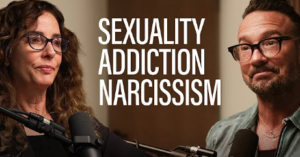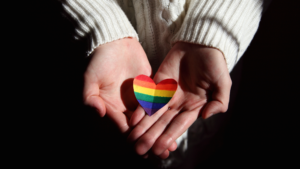Men aren’t the only ones who can’t control their sex compulsion. An investigation of female addicts.
By Liz Welch
Anna is sitting in a New York café, sipping an English Breakfast tea. Dressed in patterned tights and a black sweaterdress, the 20-something Smith College grad has auburn curls and big brown eyes. Pretty? Yes. Sexy? Sure. Sex addict? No way. But she’s currently being treated for sex addiction, seeing a therapist once a week and attending daily support groups, after an affair last year almost ruined her marriage and landed her in sex rehab. “I always knew I focused too much on men throughout my life,” explains the grad school student. “But it never threatened to derail me.” Not until last March, when her husband of less than a year grew suspicious of her late nights “studying” with a classmate. “I’d been lying to my husband for months,” she explains. “I knew it was wrong — but I couldn’t stop myself.”
Tiger Woods can relate. His now-infamous Thanksgiving Day car crash and the circus that followed — a stint in rehab, a public apology, a rumored list of 120 lovers — upended his life and put sex addiction on the tip of every gossip-loving American’s tongue. It also flamed a national debate over whether too much sex can actually be an “addiction,” or just a compulsion, or simply bad behavior. Against this backdrop, sex addiction therapists, Sex Addicts Anonymous (SAA), and Sexaholics Anonymous (SA) are all reporting a surprising trend: The number of women seeking treatment is surging.
What exactly is sex addiction? New York- based sex therapist Mavis Humes Baird defines it as any sexually related activity that is having a destructive effect on your life. Sufferers latch on to a behavior — masturbation, pornography, anonymous hookups, or standard affairs — until it starts to take over their lives. “The physical symptoms include intense cravings, high tolerance, loss of control, and, in the later stages, dependence and compulsion,” Humes Baird explains. “And the mental symptoms are obsession, denial, and the illusion of control. For addicts, there’s always a progression — you seek more of the behavior despite its devastating consequences on your life.” This might mean blowing the rent money on porn sites, trolling Craigslist for unprotected sex with strangers, or putting a loving marriage at risk over a meaningless affair.
And just as a heroin addict chases a substance-induced high, sex addicts are bingeing on chemicals — in this case, their own hormones, says Alex Katehakis, a licensed family and sex therapist and the clinical director of the L.A.-based Center for Healthy Sex. “For women vulnerable to addiction, the post- intercourse release of the bonding hormone oxytocin, coupled with the dopamine high triggered by the sex act, can put them on a neurobiological roller coaster,” she says. Baird agrees: “They’re seeking the neurochemical cascades resulting from their addictive behavior.”
Not everyone’s convinced. Dr. Michael First, professor of clinical psychiatry at Columbia University, says that while MRI studies suggest that gambling addicts react to the blackjack table in the same way that cocaine addicts react to a line, there are no comparable studies for sex. “It’s a biological process, and there’s a limit to how long you can do it,” he says. “So the analogy breaks down.” To call a natural, pleasurable human behavior addictive begs the question: Where do draw the line? How do you distinguish between a strong sex drive and a condition requiring medical attention?
The American Psychiatric Association is trying to do just that, as it reviews whether to include “hypersexual disorder” in its next edition of the Diagnostic and Statistical Manual of Mental Disorders, the Bible of mental illness. Defined roughly as spending “excessive time consumed by sexual fantasies and urges … and repetitively engaging in these sexual fantasies in response to dysphoric mood states, such as anxiety or depression … ,” if it passes muster, it will bring sex addiction, if not completely out of the realm of late-night TV jokes, slightly further into the legitimate medical community.
To Veronica, a 39-year-old social worker who became hooked on porn in the throes of a bad breakup, sex addiction is no joke. “My boyfriend stopped with me, and I was looking for other ways to get off,” she explains. “Soon I was masturbating to porn with the window open, hoping someone would see me.” By day, she was a buttoned-up temp at a law firm; by night, she was online, having sex chats with strangers and watching hard-core videos. Then one evening, she stumbled upon child pornography. “It made me sick to my stomach,” she says, “but I kept looking.” The next day, she found an SAA meeting.
“Throughout my 20s, I’d equated hooking up with random men in bars with sexual freedom. It made me feel powerful,” says Veronica. The sex would be thrilling — until she climaxed. “That’s when the fantasy would come crashing down and I’d feel like garbage,” she says. Rather than dwell on the bad feelings, she would seek out her next fix. “I’d convince myself, Oh, God, that was so hot, and start chasing the high again,” she says. Even after she was sexually assaulted — twice.
While Baird can’t pinpoint exactly what causes sex addiction, she says that many addicts have experienced physical, sexual, or emotional abuse and were raised in “chaos, or a rigid, disengaged family.” She administers a 250-question battery — Do you feel controlled by your sexual desire? Have you felt degraded by your sexual experiences? — to identify the abnormal behavior, the length of time spent engaging in it, and the effect it’s having on the patient’s life.
But how does one define normal in a society where casual sex is broadcast as liberating and empowering — threesomes are glorified on Gossip Girl; having “friends with benefits” is considered cool; and porn is not only easily and anonymously accessible, but often defended as feminist? Very subjectively, according to Baird. “Maybe Samantha in Sex and the City is having a blast, or maybe she’s obsessed and her whole life is controlled by sex,” she says, adding that, to her mind, many familiar sexual behaviors — the woman in a series of destructive relationships; the myth of nymphomania — can be symptoms of addiction.
Equally subjective is what may constitute “sexual sobriety.” For Veronica, whose new boyfriend knows her history, it “doesn’t mean never having sex again. It means taking it slowly within the context of a committed relationship,” she says. She was the sole woman in her first SAA group in 2001; today, she meets weekly with a dozen women in an all-female group. “My last relapse was in 2004, when I used pornography to masturbate,” Veronica says. “I knew if I didn’t stop, soon I’d be right back to the worst of it: violent, degrading, abusive porn, hours or days lost, hating myself but unable to stop watching and thus hurting myself.” Knowing one taste could trigger an insatiable craving, she called a fellow addict, who talked her down. “People may say sex addiction doesn’t exist,” she says, “but for me, it’s painfully real.”
Anna, the grad student, spent seven weeks at sex rehab in Arizona — at a cost of $30,000. She emerged having given up alcohol, which she believes fueled her sex addiction, and newly committed to her marriage. She returned to New York, found a therapist, joined AA, and started couples counseling with her husband. Long-term recovery will be a lifetime commitment for Anna, according to Baird, who says that studies show a combination of 12-step meetings and addiction-focused talk therapy is the most effective treatment. And as the debate rages on over the legitimacy of sex addiction, Baird’s waiting room sees a steady stream of women like Veronica and Anna, who saw their lives tangibly improve after they self-identified as “sex addicts.” For both women, acknowledging that they had a problem was the first step to leading a normal, manageable life. “Sex addiction is not about getting away with something,” says Baird. “It’s about taking responsibility for yourself, your behavior, and your life.”
Liz Welch is an award-winning whose work has appeared in The New York Times, Life, and Inc. Magazine. Her memoir, The Kids Are All Right, was released in paperback in September.


